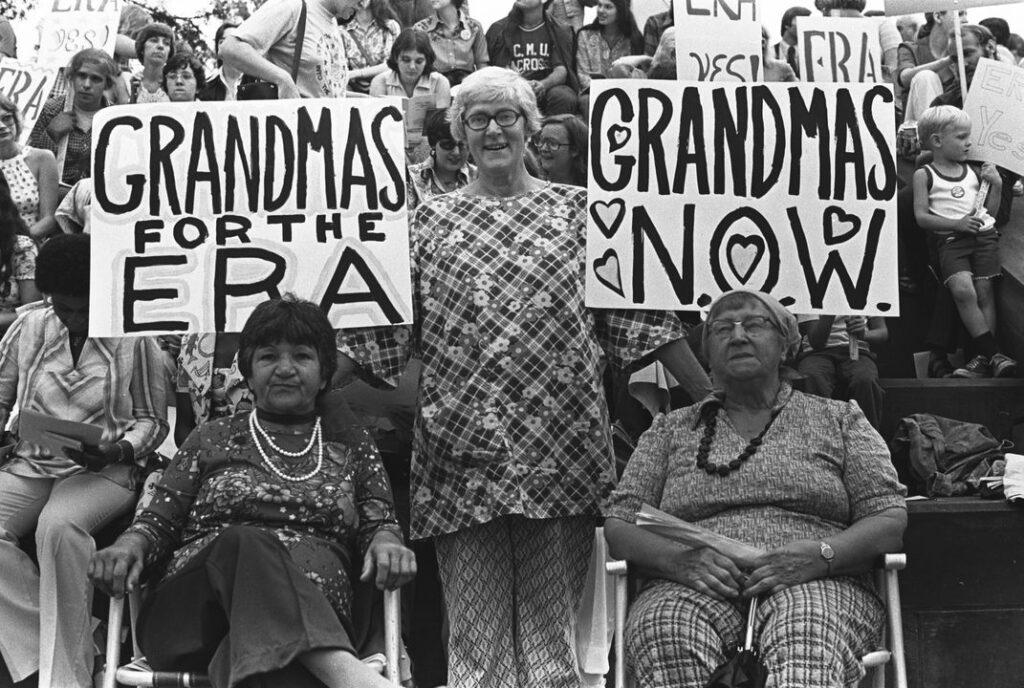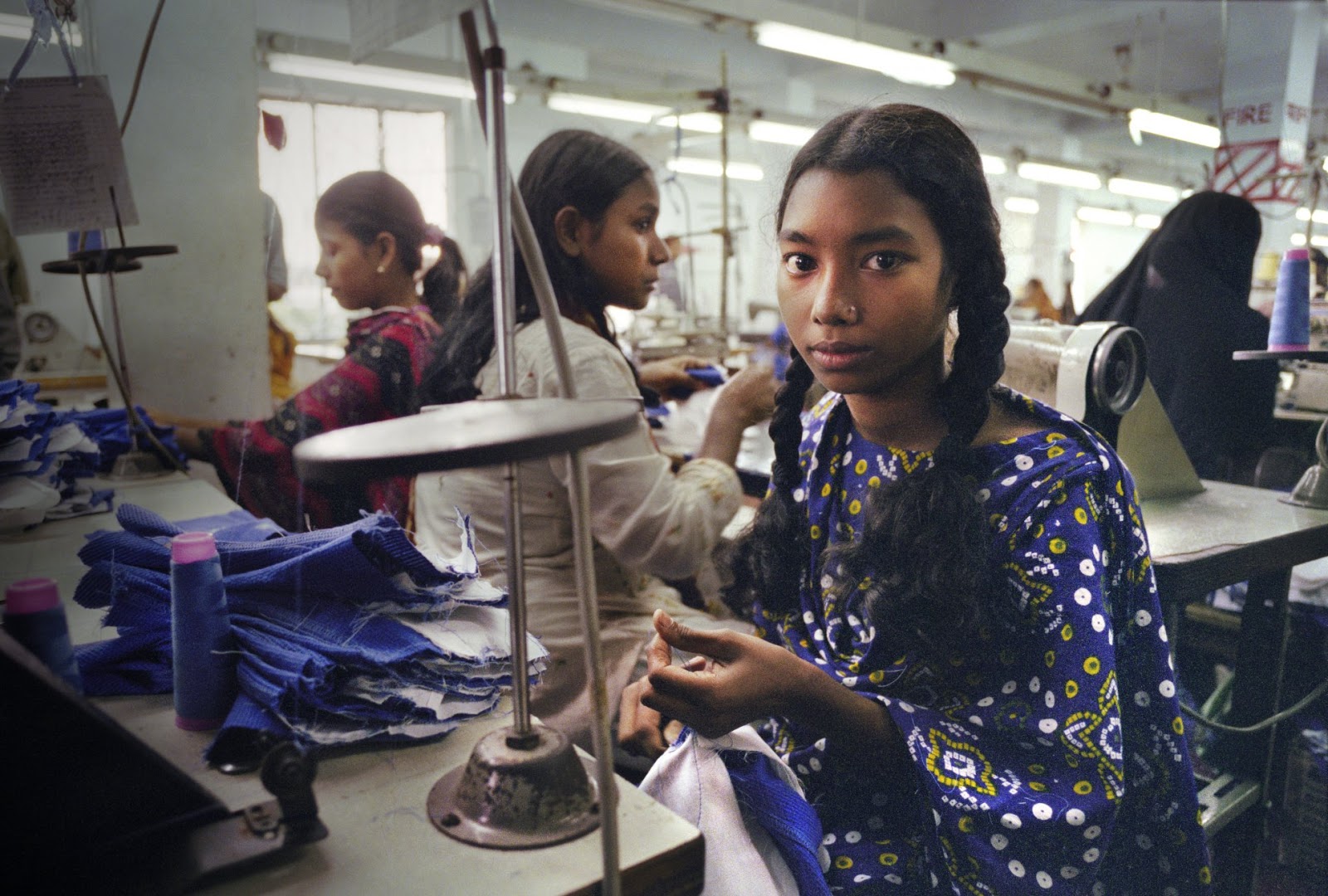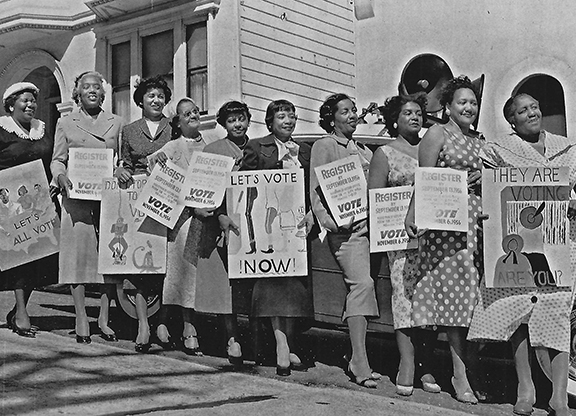
source: https://www.aaihs.org/is-equality-enough-black-feminists-views-of-justice/

source: https://www.aaihs.org/is-equality-enough-black-feminists-views-of-justice/
The image of a woman dedicating herself to her husband, home and children was the ideal image for men in the 1950’s. Woman weren’t treated as equals and instead treated as in home maids, caregivers, nannies with no form of compensation. In the excerpt from the reading “The Feminine Mystique” by Betty Friedan, Friedan states how women’s only worry, back then, was revolving around her home husband and children. Because they were told by their husbands to maintain their beauty and to take care of their homes, a majority of women were categorized as a housewife as an occupation. However, Friedan mentions how they longed for more out of their domestic lives. Friedan states “It was a strange stirring, a sense of dissatisfaction, a yearning that women suffered in the middle of the twentieth century in the United States. Each suburban wife struggled with it alone…she was afraid to ask even of herself the silent question – ‘Is this all?’” (1). Women having a career and being independent, seemed to be looked down on. Because the image of a career women wasn’t attractive, and this meant that men had no control over them. So-called “experts” would tell these women, that longing they feel is due to jealousy of men and their needs should revolve about fulfilling the role of a mother and a good wife. This expectation of women to be a household material and not her own person made it difficult for women to pursue careers. Even up to this day women continue being placed in second place. When Friedan states “A girl should not expect special privileges because of her sex, but neither should she “adjust” to prejudice and discrimination.” (3), Freidan is saying how women should be treated as equals with men but should not be humiliated and discriminated. Women should not “adjust” to their toxic workplace because “that’s what everyone does”, she should adjust in completing her career goals, but should never put her head down, to be given an opportunity. Furthermore, in the reading “The Politics of Housework” by Pat Mainardi, Mainardi mentions how women are conditioned from a young age that they are the ones responsible for the housework, while men are the ones who are meant to bring home the money. Mainardi mentions how men recognize that housework is not fun and will bring up excuses as to what they will do and what they won’t do, when it revolves around housework. Such as doing certain once a month jobs, while leaving the daily chores up to women. Mainardi mentions “‘I hate it more than you. You don’t mind it so much.’ MEANING: Housework is garbage work. It’s the worst crap I’ve ever done. It’s degrading and humiliating for someone of my intelligence to do it. But for someone of your intelligence…” (3). This example is meant to demonstrate that men don’t believe they have to work in their home, because it not up to them to clean and cook, domestic styles just don’t fit within their toxic masculinity. However, for women, men believe they were made to clean up after them. The snapshot by Caitlyn Howell, is a perfect image as to how these men would think. They view women as a homeworker, who takes care and cleans up after them, they view women as their mothers and not as their wives.
Hearing about the Triangle Shirtwaist Factory Fire is very heartbreaking. The people working at this location were mainly young women. These young women who worked constantly with very little pay were killed in an incident that could have very well been prevented. According to the video on May 25, 1911, the place in which the factory was located was by Washington square park which was “one of the wealthiest neighborhoods in the city”. This fact alone is very disappointing. If the factory was located in one of the wealthiest parts of the city, you would think that these locations would have the at least proper conditions to work in, however time back then were much harsher than now. However, the factory was by definition a sweatshop. It was also very disappointing to hear that the company itself failed these women. Because the factory had no sort of sprinkler system, it had elevators that didn’t work and a fire escape that was too weak that ended up collapsing. According to the other video “Triangle Returns”, The emergency exits were blocked, not allowing the women to escape from the building. Emergency exits are there for a reason for emergencies, but the company had blocked these exits because they feared that the women would have stolen the products that were being made or would be sneaking to take breaks. So, in order to prevent theft, they had come this conclusion of blocking emergency exits, which at ended up not only destroying their products but having their workers killed. The manufacturers of the factory were found Not Guilty in their trail for manslaughter. The incident of the Triangle Shirtwaist Factory was used as a cautionary tale, that ended up helping the ILGWU to put the Sullivan-Hoey Fire Prevention Law into place.
The video “Triangle returns” also brings up a similar incident to that of The Triangle Shirtwaist Factory Fire. The similar incident occurred across the world in Bangladesh. The date was dec. 14. 2010, a fire had broken out in a factory in Bangladesh during a lunch break. Although the fire was occurring the workers were calm at first with the hopes that everything would be ok once they reached the emergency exits. However, the flames were too big that it blocked the exits, this made the workers try to leave from other fire exits but they were locked. Just like the incident of the Triangle Shirtwaist Factory, the workers began jumping out the windows in desperations. The story just repeated itself. And once again both the incidents had the exits locked to prevent theft. This just goes to show how much a company values their products more than these people’s lives. The workers in the Bangladesh factory were paid much, much less than what the workers in America were paid years ago. The snapshot by Jasmin H. where it shows a woman holding up a sign that says “I don’t want to DIE for FASHION” is a very powerful image because it discusses how the pay that these workers are receiving is so little, with such high risks. Of course, many people are in desperate need of work but the way these sweatshops pay these workers is unbelievable considering the income that they are receiving for the products being made.
Finally, the reading of “Virginia just became the 38th State to Pass the Equal Rights Amendment”, speaks on exactly that. The reading of the timeline in women’s suffrage, showed how the ERA has yet to be fully placed. According to the reading the ERA has fulfilled the “requirement that three-quarters of the states approve an amendment in order to add it to the U.S. Constitution”. Although the proposition for the ERA had been proposed centuries ago, now in modern day are we so close for the ERA to be added to the constitution. According to the article, the “… ratification seemed to be a given, with states quickly approving the amendment, but those ratifications slowed to a trickle. Crucially, the amendment’s passage had had a major consequence: mobilizing anti-feminists, including its arch- opponent Phyllis Schlafly, to defeat it.”. The article mentions that it won’t be an easy ride and will most likely not be added anytime soon. Because there was a deadline for the ratification of the ERA it makes it difficult.


No matter how many years pass, in every generation there will always be women fighting for their rights. Women taking the lead for change. According to timeline “One Hundred Years toward Suffrage”, it shows that in 1776 where John Adams tells his wife, Abigial Adams, “The Declaration’s wording specifies that ‘all men are created equal’”, after she writes hm to not forget about the women. This was only the beginning of the timeline and I felt sick to my stomach. There were many more injustices that lead up to the Women’s Suffrage Movement. The Women’s Suffrage movement was a necessary step for women’s voices to be heard and be granted the right to vote. After a long fight, the ratification of the 19th amendment gave women the right to vote. And although both women of color and white women fought on the same side, the women of color were not given the chance to vote with the white women until much later. In the video “Untold Stories of Black Women in the Suffrage Movement”, the narrator quotes Susan B. Anthony to state she would not demand the vote of a person of color before the vote of a woman. Clearly, there were some women who had support from women of color, who would not give that same support back. Although she is one of the many leaders how fought for women’s right and changes for women It was quite upsetting for how long I was unaware of this statement she made.
In the video it also demonstrates how women of color gave white women their support. When parading for the women’s right convection, women of color were allowed to participate, but had to be in the back of the parade. Ida B. Well, was not ok with this and as soon as the march began, she marched to the front to join the white women in their march. May I say, this is such a powerful move of her. She showed that her voice will not be shut down. Race should not be an issue when fighting for the same rights. The Snapshot of Vanique has a clear image of how certain white women did not feel that the right of voting for women should also make women of color eligible. The quote under image is a clear statement. “Vote for WHITE women”, which is such a sad and unfortunate way of thinking. According to the timeline, in 1923, “The National Woman’s Party first proposes the Equal Rights Amendment to eliminate discrimination on the basis of gender. It has never been ratified”. Besides showing up in the timeline, the video states how we women have come so far to combat these injustices. We are giving ourselves the chance to become something greater for the world, yet there are still many injustices that we must face. This makes me think back to the current issue that women are facing. The government wanting to be in control of our bodies by making abortions illegal. Our fights as women will never be over.

Activism is using one’s voice to campaign about bringing political or social change. Over the years issues have only risen with very little positive outcomes. Which is why precisely why activism has been used as a form of protest to voice out our concerns to be heard and show how much the issues are impacting us. In readings such as How to Think like an Activist I by Wendy Syfret, there are various examples as to how activism was used to create the change in our world today. Syfret states “people from all over the world are confronting issues such as climate change, racial injustice, xenophobia, and violence against women, people of color and non-binary individuals” (12). These issue that Syfret mentions are current issues that we are seeing at a global scale, and not much has changed. A lot of protests and movements are being formed to stand up against these injustices through social platforms and protests out on the streets of our cities.
I believe that Syfret mentions how young people have brough activism to a new level. They mention “one of the unique qualities young people can bring into activism is an ability to be heard” (18). I must say that I have seen how much our current generation has brough a lot of awareness than the older generation have towards current social issues. I don’t believe that it’s because older generations are incapable, but like how Syfret mentions “Today you don’t need an army to act just a wi-fi connection” (24), our generation has been able to put issues out there through our social platforms. Movements and voicing out people’s stories have been done through social media. Even throughout our global pandemic that is COVID-19, the issues that have risen won’t die down, on the contrast awareness for all these social injustices has only grown bigger.
Not only is there a need for a social change but there was a need for political change. When watching the Netflix documentary Knock down The House, Alexandria Ocasio-Cortez is a representation of those in the Queens borough and many more for change for the better. The other women who were running up for candidates for congress, Amy Velia, Cori Bush, and Paula Jean Swearengin, all did so much to have their voices heard and bring awareness to those in their communities for change, a change that past congress men have failed to accomplish their promises. AOC is such a great representation; she isn’t shy of bringing up the issues the community and is bold for holding those accountable for their lack of help. When running up against Joseph Crowley, we are told how the strategy for Crowley is to just win to continue having a job instead of facing the global issues straight on and responding to the issues the community has. Just as the snapshot by Allena McKenzie illustrates actions do speak louder than words. Our community does so much more for a change such as preparing protests and movements than our own government will do. In fact, our own government will do the most, to shut down protests and voices.
